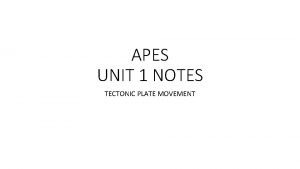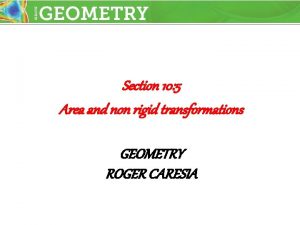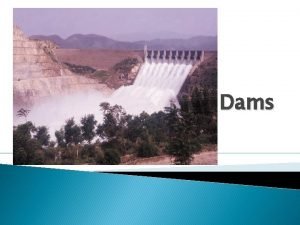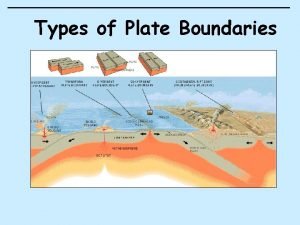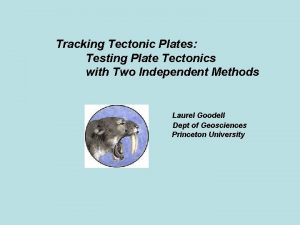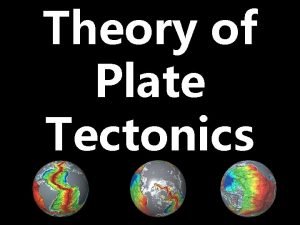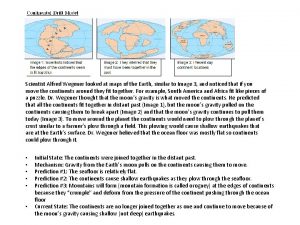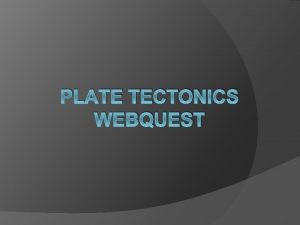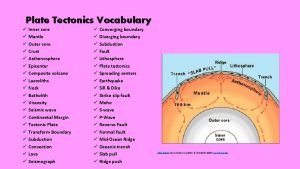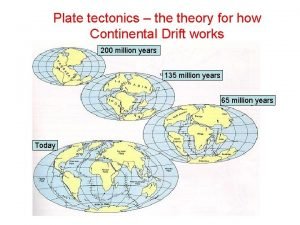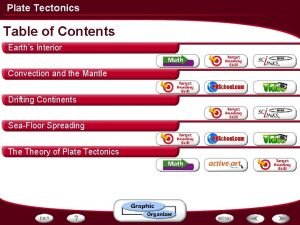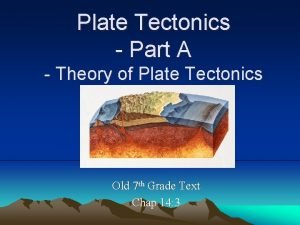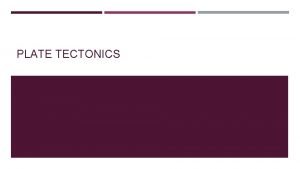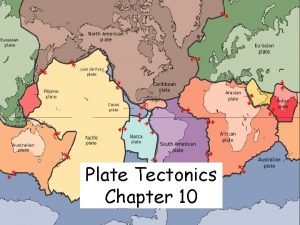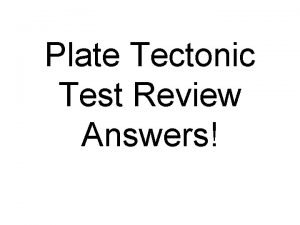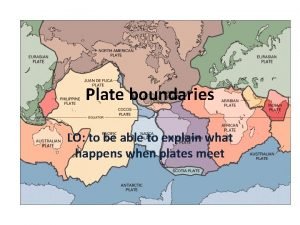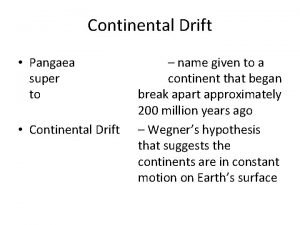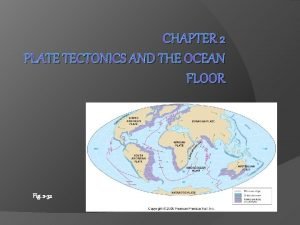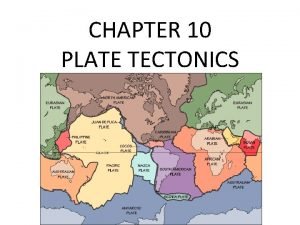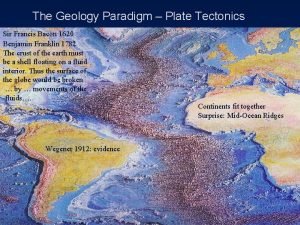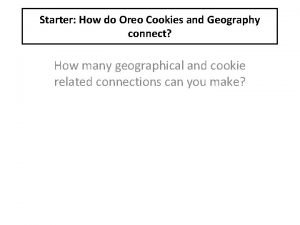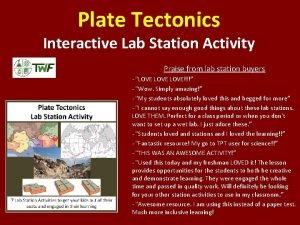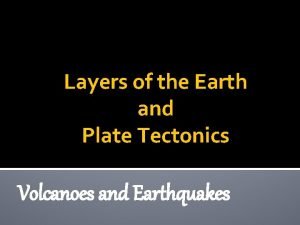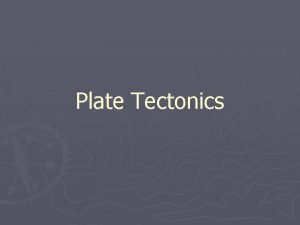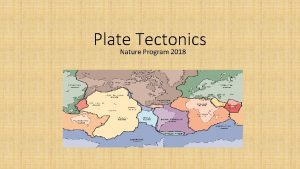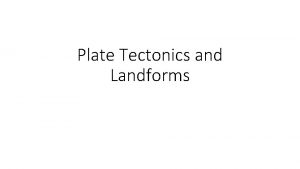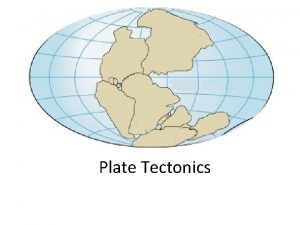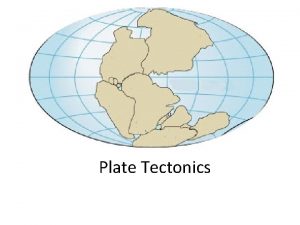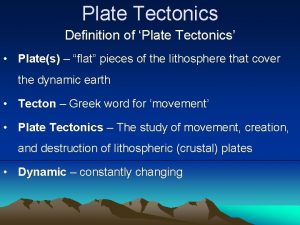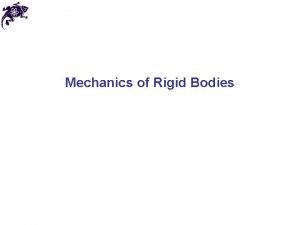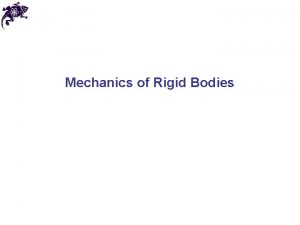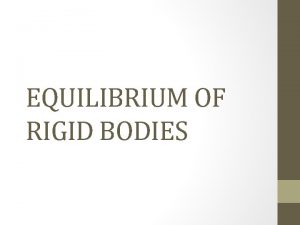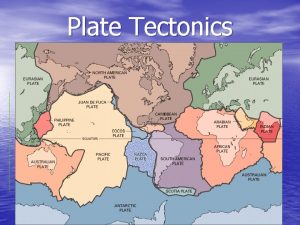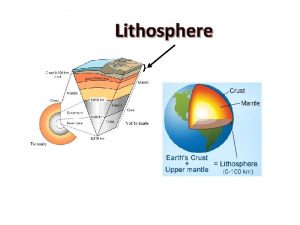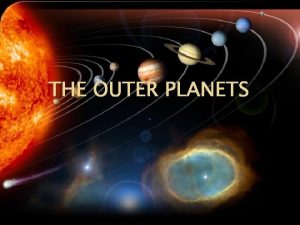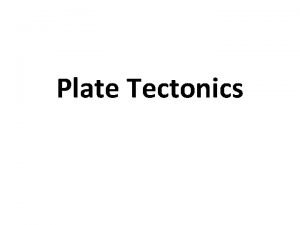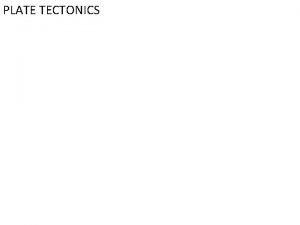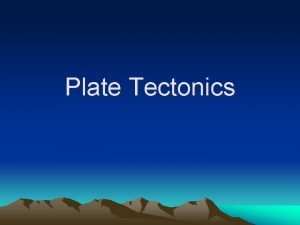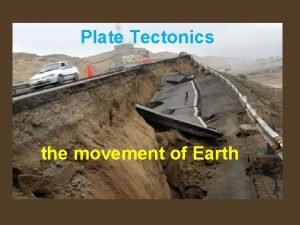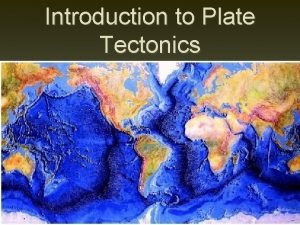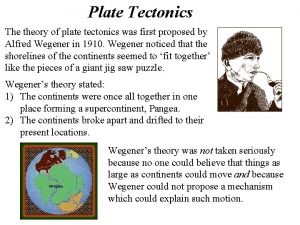Plate Tectonics Definition Plate Rigid rocky outer surface

































- Slides: 33

Plate Tectonics

Definition Plate: Rigid, rocky outer surface of the Earth Tectonic: To build or destroy The processes by which the rocky plates of the planet move and interact with each other

Internal Structure of the Earth lithosphere plates inner core solid iron mantle hot dense rock outer core liquid iron

Lithospheric Plates Oceanic: Continental: thin, heavy, mostly lava flows thick, light, mostly granite Asthenosphere Weak, plastic upper mantle

Lithospheric Plates

Diverging Plate Boundaries Where plates pull apart from each other Stretching & thinning High heat flow (New Crust Created)

Diverging Plate Boundaries Key landform: mid-oceanic ridges volcanic mt. ranges axial valley 1000’s miles long 1 -2 miles tall

Converging Plate Boundaries Where plates collide Subduction zone: collision between oceanic and continental lithosphere (Crust Destroyed)

Subduction zones Key landforms: trenches & volcanic arcs

Transform Plate Boundaries Where plates slide side by side Key landform: faults (Crust neither destroyed or created)

Driving Force thermal convection / convection currents pushes up at ridges plates spread away hot rock cold rock plate sinks and subducts

Geologic activity at plate margins Volcanism: C, D Earthquakes: C, D, T Rock Deformation: C, D, T

Evidence: shape of continents The margins of some continents look like they could fit together First proposed by Alfred Wegener

Fossil Evidence

Evidence: volcanoes Nonrandom occurrence of volcanic activity

Evidence: earthquakes Nonrandom occurrence of earthquakes Shallow at diverging margins deep at converging margins

Evidence: hot spots Stationary upwellings of heat away from plate margins

Evidence: hot spots As plates move, the volcanoes are carried away from the hot spot Only volcanoes near the hot spot are active Can determine direction and speed of the plate motion

Evidence: age of seafloor rocks Youngest rocks are found at the mid oceanic ridges Oldest rock are found farthest from the ridge

Evidence: paleomagnetism Earth has a strong magnetic field Iron rich volcanic rocks record Earth’s magnetic field at the time they form

seafloor paleomagnetic record Bands of alternating polarity Symmetrical about the mid oceanic ridges

seafloor paleomagnetic record lava forming at the ridges picks up the current magnetism, then gets pushed out of the way as newer lava forms Records of the growth and spreading of the seafloor

seafloor paleomagnetic record The alternating polarity represents complete reversals of Earth’s magnetic field

continental paleomagnetic record The location of magnetic poles on separate continents appear to wander with time If the poles haven’t moved significantly, then the continents did Use overlapping poles to reconstruct the past positions of the continents

Plate Tectonics in the PNW Cascadia subduction zone

Plate Tectonics in the PNW Cascades volcanic arc

Plate Tectonics in the PNW Juan de Fuca & Gorda mid ocean ridges

Plate Tectonics in the PNW Blanco & Medocino fracture zones

Plate Tectonics in the PNW “exotic terranes islands carried by the plates Attached to the North America continent

seafloor paleomagnetic record Bands of alternating polarity Symmetrical about the mid oceanic ridges

Evidence: paleo-environments

Evidence: distribution of mountains

Importance of Plate Tectonics
 Plate tectonics definition
Plate tectonics definition Plate tectonics definition apes
Plate tectonics definition apes Inner core and outer core
Inner core and outer core Non-rigid transformations
Non-rigid transformations Rigid dam
Rigid dam What is rigid and non rigid
What is rigid and non rigid Rigid outer covering of plant cells
Rigid outer covering of plant cells Plate tectonics vs continental drift
Plate tectonics vs continental drift What are the four types of boundaries
What are the four types of boundaries Evidence of the theory of plate tectonics
Evidence of the theory of plate tectonics Plate tectonics theory states that
Plate tectonics theory states that Continental drift theory and plate tectonics theory
Continental drift theory and plate tectonics theory Compare continental drift and plate tectonics
Compare continental drift and plate tectonics Continental drift webquest
Continental drift webquest Plate tectonics vocabulary worksheet
Plate tectonics vocabulary worksheet Continental drift
Continental drift Mantle convection and plate tectonics
Mantle convection and plate tectonics Driving force of plate tectonics
Driving force of plate tectonics Plate boundaries
Plate boundaries Summarize the theory of plate tectonics
Summarize the theory of plate tectonics Harry hess and seafloor spreading
Harry hess and seafloor spreading Continental drift theory and plate tectonics theory
Continental drift theory and plate tectonics theory Mantle magma
Mantle magma Collision plate boundaries
Collision plate boundaries Edible plate tectonics
Edible plate tectonics A plate tectonics puzzle worksheet answer key
A plate tectonics puzzle worksheet answer key From now
From now Fossils as evidence of continental drift
Fossils as evidence of continental drift Francis bacon plate tectonics
Francis bacon plate tectonics Oreo cookies and plate tectonics answer key
Oreo cookies and plate tectonics answer key Plate tectonics interactive lab
Plate tectonics interactive lab Divergent boundary oreo
Divergent boundary oreo Two regions of the mantle
Two regions of the mantle Explain the theory of plate tectonics.
Explain the theory of plate tectonics.

